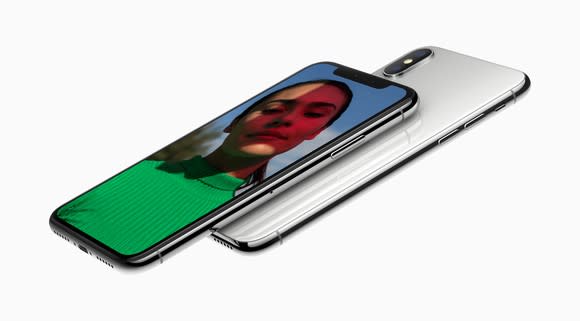Apple Inc.'s iPhone Camera Problem
When Apple (NASDAQ: AAPL) announces new iPhone models each year, the presenter -- usually Apple marketing chief Phil Schiller -- talks quite a lot about the improvements the company made to the camera subsystems of its new phones.
These improvements generally tend to be substantial, as improvements in image processor technology, camera sensors, and lens design coalesce into a true generational leap for iPhone cameras.

Image source: Apple.
Unfortunately, while Apple generally delivers big improvements each year, in recent years, Apple's flagship phones have either trailed or merely matched the competition in terms of camera performance.
For example, DXOMark gave the cameras on the iPhone 8 and iPhone 8 Plus scores of 92 and 94, respectively. The iPhone X, which has a slightly more advanced camera subsystem, achieved a score of 97 in DXOMark's battery of tests. The iPhone X is among the best phones today in terms of DXOMark score -- matching the Huawei Mate 10 Pro and trailing the Pixel 2 by one point.
However, the iPhone X will remain Apple's top smartphone offering until September, while competing smartphone vendors -- like Huawei, Samsung (NASDAQOTH: SSNLF), and several others -- will likely release new flagship devices in the spring that'll easily surpass the iPhone X in DXOMark.
Here's why that's an issue for Apple's iPhone business.
Customers care about cameras
There's a reason smartphone vendors invest heavily in developing capable new cameras -- customers care a lot about camera quality! This was quite evident in the degree of success the iPhone 7 Plus enjoyed in the market relative to the standard iPhone 7, which was likely driven by the iPhone 7 Plus' then-unique dual rear-facing camera subsystem.
If camera quality is a significant factor in customers' smartphone purchases, then it's only natural that smartphone vendors are going to invest significantly in trying to build the best smartphone cameras they can.
This leads us to Apple's problem.
A problem and a prediction
Later this month, Apple's biggest rival, Samsung, is expected to release its new Galaxy S9 and Galaxy S9+ flagship smartphones. These phones are expected to include new camera sensors and redesigned optics that should boost image quality, particularly in low-light situations (these are really hard to get right, especially in mobile cameras).
I have little doubt that these phones will crush the iPhone X in DXOMark, with each delivering composite scores well over 100 (DXOMark is made up of many sub-tests that measure different aspects of a mobile camera). This is the kind of thing Samsung will be able to aggressively market against Apple's current iPhone lineup.

Image source: Apple.
Not only could Samsung one-upping Apple in terms of camera performance for a six- to seven-month stretch potentially put a lid on the kind of share gains Apple could see in the premium portion of the smartphone market, but there's even a chance that such an obvious deficiency could lead to share losses for Apple until it introduces its new iPhone models in September.
How Apple gets around this
Apple's annualized research and development spending is now roughly $14 billion (and seemingly still growing), making it one of the biggest spenders in tech. Apple's best path forward is to dedicate a significant portion of its research and development budget toward building the absolute best mobile cameras in the marketplace.
Fortunately for Apple, I think the company keenly understands the importance of camera competitiveness and is likely investing appropriately in future mobile camera development.
Where Apple will need to really change things up is in the amount of the total iPhone bill of materials it dedicates to the cameras. If Apple continues to sell iPhone X-like devices with $999-plus price tags, then it should be fairly straightforward for Apple to include more sophisticated camera technologies into those devices since the devices themselves are more expensive.
If Apple tries to push pricing on iPhone X-class devices downward, then Apple may have to either sacrifice on its per-device margins to improve the competitiveness of its cameras, or simply bite the bullet and accept that its latest iPhone models will be eclipsed by competing devices less than halfway through their respective product cycles -- potentially limiting device shipment growth and possible market share gains.
More From The Motley Fool
Ashraf Eassa has no position in any of the stocks mentioned. The Motley Fool owns shares of and recommends Apple. The Motley Fool has the following options: long January 2020 $150 calls on Apple and short January 2020 $155 calls on Apple. The Motley Fool has a disclosure policy.

 Yahoo Finance
Yahoo Finance 